I have a UITableView inside a UIViewController as part of the view. I'm trying to autoresize the table cells based on the length of the text. it doesn't set the text of the textview and the cell ends up at standard height for the idCellTextView-cell. I've searched around and am trying to use pinning in auto layout from the textview inside the cell relative to the content view and the code as shown below. :
tableView.estimatedRowHeight = 70
tableView.rowHeight = UITableViewAutomaticDimension
The rest of the view controller thats relevant to the problem is shown under:
class ExperimentViewController: UIViewController, UITableViewDelegate, UITableViewDataSource, UITextViewDelegate {
var expId: String = ""
let experimentDescription: String = ""
var cellDescriptors: NSMutableArray!
var visibleRowsPerSection = [[Int]]()
let notificationCenter = NotificationCenter.default
override func viewDidLoad() {
super.viewDidLoad()
//TABLE CELLS
loadCellDescriptors()
tableView.tableFooterView = UIView()
tableView.layoutMargins = UIEdgeInsets.zero
tableView.separatorInset = UIEdgeInsets.zero
tableView.delegate = self
tableView.dataSource = self
tableView.isHidden = true
tableView.estimatedRowHeight = 70
tableView.rowHeight = UITableViewAutomaticDimension
tableView.register(UITableViewCell.self, forCellReuseIdentifier: "cellIdentifier")
tableView.register(UINib(nibName: "CustomCell", bundle: nil), forCellReuseIdentifier: "idCellNormal")
tableView.register(UINib(nibName: "HintCell", bundle: nil), forCellReuseIdentifier: "idCellTextView")
//ADD VIEWS
baseView.addSubview(backgroundImage)
baseView.addSubview(foregroundImage)
baseView.addSubview(nameLabel)
baseView.addSubview(segmentedController)
baseView.addSubview(descriptionText)
baseView.addSubview(hint)
baseView.addSubview(tableView)
}
/*
Get property list for the different cells we want to have in the hint table
*/
func loadCellDescriptors() {
if let path = Bundle.main.path(forResource: "CellDescriptor", ofType: "plist") {
cellDescriptors = NSMutableArray(contentsOfFile: path)
getIndicesOfVisibleRows()
tableView.reloadData()
}
}
/*
Returns number of rows in a given section
*/
func tableView(_ tableView:UITableView, numberOfRowsInSection section:Int) -> Int {
return visibleRowsPerSection[section].count
}
/*
Returns number of sections in table
*/
func numberOfSectionsInTableView(tableView: UITableView) -> Int {
/*if cellDescriptors != nil {
return cellDescriptors.count
}
else {
return 0
}*/
print(items.count)
return 3
}
/*
Sets up the cell contents
*/
func tableView(_ tableView: UITableView, cellForRowAt indexPath: IndexPath) -> UITableViewCell {
let currentCellDescriptor = getCellDescriptorForIndexPath(indexPath)
let cell = tableView.dequeueReusableCell(withIdentifier: currentCellDescriptor["cellIdentifier"] as! String , for: indexPath) as! CustomCell
if currentCellDescriptor["cellIdentifier"] as! String == "idCellNormal" {
print("1")
if currentCellDescriptor["primaryTitle"] != nil {
cell.labelOfRow.text = "Hintet er"
cell.accessoryType = UITableViewCellAccessoryType.disclosureIndicator
}
} else if currentCellDescriptor["cellIdentifier"] as! String == "idCellTextView" {
cell.textView.delegate = self
cell.textView.isEditable = false
cell.textView.isSelectable = false
cell.textView.isScrollEnabled = true
cell.textView.text = "orem Ipsum er rett og slett dummytekst fra og for trykkeindustrien. Lorem Ipsum har vært bransjens standard for dummytekst helt siden 1500-tallet, da en ukjent boktrykker stokket en mengde bokstaver for å lage et prøveeksemplar av en bok. Lorem Ipsum har tålt tidens tann usedvanlig godt, og har i tillegg til å bestå gjennom fem århundrer også tålt spranget over til elektronisk typografi uten vesentlige endringer. Lorem Ipsum ble gjort allment kjent i 1960-årene ved lanseringen av Letraset-ark med avsnitt fra Lorem Ipsum, og senere med sideombrekkingsprogrammet Aldus PageMaker som tok i bruk nettopp Lorem Ipsum for dummytekst.orem Ipsum er rett og slett dummytekst fra og f"
}
cell.layoutMargins = UIEdgeInsets.zero
return cell
}
/*
Handles row selections
Finds the index of the cell that was selected, checks if it is/can be expanded and animates in the additional rows
*/
func tableView(_ tableView: UITableView, didSelectRowAt indexPath: IndexPath) {
let indexOfTappedRow = visibleRowsPerSection[indexPath.section][indexPath.row]
let cellDescriptor = cellDescriptors[indexPath.section] as! NSMutableArray
let cell = (cellDescriptors[indexPath.section] as! NSMutableArray)[indexOfTappedRow]
var shouldExpandAndShowSubRows: Bool = false
//Checks if cell is expandable, if it is we check if cell isn't already expanded. If it isn't we can expand the cell
if (cell as AnyObject)["isExpandable"] as! Bool == true {
shouldExpandAndShowSubRows = false
if (cell as AnyObject)["isExpanded"] as! Bool == false {
shouldExpandAndShowSubRows = true
}
}
(cell as AnyObject).setValue(shouldExpandAndShowSubRows, forKey: "isExpanded")
//Makes the cells inside the specific section visible
for i in (indexOfTappedRow + 1)...(indexOfTappedRow + ((cell as AnyObject)["additionalRows"] as! Int)) {
(cellDescriptor[i] as AnyObject).setValue(shouldExpandAndShowSubRows, forKey: "isVisible")
}
//Update the overview of the currently visible rows
getIndicesOfVisibleRows()
//Reload the sections to see the changes
tableView.reloadSections(NSIndexSet(index: indexPath.section) as IndexSet, with: UITableViewRowAnimation.fade)
}
/*
Get overview of the rows that are currently visible
*/
func getIndicesOfVisibleRows() {
visibleRowsPerSection.removeAll()
for currentSectionCells in cellDescriptors.objectEnumerator().allObjects as! [[[String:AnyObject]]] {
var visibleRows = [Int]()
for row in 0...((currentSectionCells).count - 1) {
if currentSectionCells[row]["isVisible"] as! Bool == true {
visibleRows.append(row)
}
}
visibleRowsPerSection.append(visibleRows)
}
}
/*
Get cell descriptor from file for specific cell
*/
func getCellDescriptorForIndexPath(_ indexPath: IndexPath) -> [String: AnyObject] {
let indexOfVisibleRow = visibleRowsPerSection[indexPath.section][indexPath.row]
let cellDescriptor = (cellDescriptors[indexPath.section] as! NSMutableArray)[indexOfVisibleRow] as! [String: AnyObject]
return cellDescriptor
}
}
